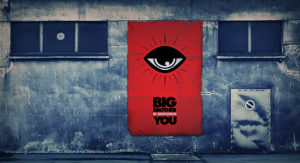Do the FBI and Department of Justice Want a Photo of Every American?
A recent hearing by the House Committee on Oversight and Government Reform reviewed law enforcement use of facial recognition technology and got some troubling information.

United State of Art / CC BY-SA 2.0
A recent hearing by the House Committee on Oversight and Government Reform revealed some troubling news concerning privacy rights: Using facial recognition technology, the FBI has captured images of more than half of all adult Americans and is storing them in perpetuity in databases for law enforcement agencies to access. The technology is part of a 2010 FBI program called Next Generation Identification. The program uses facial recognition, finger and palm prints, and iris scans to track people and put their information in repository systems for law enforcement use. No warrant is required, and everyone, including people with no criminal record, can be recorded.
On March 22, the House Committee on Oversight and Government Reform met to review the FBI’s facial recognition policies.
Alvaro Bedoya, executive director of the Center on Privacy and Technology at Georgetown Law and an adjunct law professor at the university, testified that the FBI can open an investigation and use the facial recognition system on the basis of mere allegations. Driver’s license information of millions of Americans is collected and stored in a vast network of databases that local and federal enforcement can access.
During the hearing, Rep. Paul Mitchell, R-Mich., said state agencies are not required to provide investigation or search warrants. In fact, the agencies do not even need to meet minimal U.S. standards of “reasonable suspicion” to go through the FBI database, In addition, Mitchell noted, the FBI has access to 400 million photos of Americans with this program.
Representing the FBI and Department of Justice (DOJ) was Kimberly Del Greco, deputy assistant director of the criminal justice information services division at the FBI. Del Greco offered a statement before the committee, but she evaded almost every question directed at her, much to the chagrin of committee members. When asked if facial recognition was being used by local law enforcement, she refused to answer.
Instead, Bedoya revealed:
We surveyed over 100 law enforcement agencies across the country. We found 52 that had used or were using face recognition technology. Not one required a warrant. And in most agencies, as well as the FBI, officials do not need to reasonably suspect someone of a crime before scanning and searching their face. How is this going to affect free speech? Are you going to go to a gun rights rally or a protest against the president for that matter? If the government can secretly scan your face and identify you? … We have met a college student who is now in at least two separate facial databases after a protest for peaceful disobedience. … Are there safeguards? No. If there is abuse, we would not know it.
Rep. Stephen Francis Lynch, D-Mass., believes potential issues go beyond the First Amendment:
“When you think how this could change who we are as a nation, it is very very troubling. This nation was founded on protest. It really was. And it is continually reshaped by protest. And it disturbs me greatly that whether it was the death of Freddie Gray and those protests, or the women’s protest recently that was all over the country. Millions of people. It disturbs me greatly that we are out there taking in this information. … This is really Nazi Germany here, what we’re talking about is. They had meticulous files on individuals. Most of them of Jewish faith, and that’s how they tracked their people. I see little difference in the way people are being tracked under this.”
The FBI also appears to have broken the law by not putting out privacy impact and need-of-use assessments. Diana Maurer, director of homeland security and justice issues at the U.S. Government Accountability Office (GAO), told the panel that no one has tested the accuracy of the technology since 2011, before its implementation. Maurer said the FBI needed to provide evidence that the technology was making a difference in helping its operative needs. The FBI also has its own requirements for annual operational reviews, which were never conducted.
Committee Chairman Jason Chaffetz, R-Utah, asked Del Greco, who is also the FBI section chief for biometric services, why the “GAO report asserts that the FBI failed, even though it’s directed by law, to put out the privacy impact assessment? Why did the FBI not fulfill the law? The requirement of the law.”
Del Greco responded: “I will defer to DOJ for that.”
“What do you mean defer to DOJ?” Chaffetz said. “You are DOJ. The impact assessment was submitted years late after the program was already in full use. So here’s the problem: You are required by law to put out a privacy statement, and you didn’t. Now we are supposed to trust you with hundreds of millions of people’s faces in a system that you couldn’t protect even in the 702 issue [to strengthen protections for federal employees].”
Chaffetz continued: “The point is, as the GAO has rightfully, I think, pointed out, the FBI is required by law to comply with the law. You are part of the Department of Justice, and you failed to do so. … But what scares me is the FBI and the Department of Justice proactively trying to collect everybody’s face and then having a system with a network and cameras, where, if you go out in public, that too can be collected. And then used in the wrong hands, nefarious hands, somebody in government misusing it, it does scare me. Are you aware of any other country that does this? Anyone on the panel? Is there any other country that does this?”
According to Bedoya, six major law enforcement agencies plan to use or have actively used real-time face scanning, with a quarter of body-camera vendors making provisions for face scanning with body-camera video. This capability will allow future body cameras to scan every person in sight, something that has been used with surveillance cameras.
The hearing also revealed that the use of facial recognition isn’t limited to government. Private corporations are beginning to develop and may have already implemented the technology. It appears that it is a matter of time before facial recognition technology is connected with the ability to track Americans (whose internet browsing history is now accessible) to their geolocation.
READ: House Votes to Strip Americans of Their Internet Privacy Rights
The technology also has a major technical flaw: It is not 100 percent accurate, especially with African-Americans and women. The committee found that “human verification is often insufficient as a backup and can allow for racial bias.” Inverse.com reports that “when the system was asked to pull the 50 closest-matching faces from a set of nearly 1 million, it got the right one only 86% of the time, according to a 2016 GAO report.” According to the New York Daily News, the New York Police Department has used facial recognition to investigate crimes since 2011. In 2015, a spokesperson for the NYPD revealed that the technology “misidentified” five people, who later were targeted for investigation and may well have been arrested and charged.
The New York Daily News writes:
Despite these risks, the NYPD has implemented its face recognition largely in secret. The department has refused to provide information about its system in response to requests filed under New York’s Freedom of Information law. First, the agency argued that the records were exempt from disclosure. Then it claimed it was “unable to locate” the documents requested. Finally, it reverted to the claim that the documents are exempt from disclosure because they discuss trade secrets or confidential police procedures.
Yet New York, without proper oversight, is doubling down on the technology. Right now, the Metropolitan Transportation Authority is in the early stages of acquiring a face recognition system to scan the occupants of the 800,000 cars per day at the nine bridges and tunnels connecting New York City’s boroughs.
While this Truthdig correspondent was reporting on the ground in North Dakota at the Standing Rock Reservation, many of the demonstrators and Native Americans expressed great fears over police use of facial recognition. Many believed their images had already been captured on film and subsequently logged into various databases.
Independent journalism is under threat and overshadowed by heavily funded mainstream media.
You can help level the playing field. Become a member.
Your tax-deductible contribution keeps us digging beneath the headlines to give you thought-provoking, investigative reporting and analysis that unearths what's really happening- without compromise.
Give today to support our courageous, independent journalists.






You need to be a supporter to comment.
There are currently no responses to this article.
Be the first to respond.